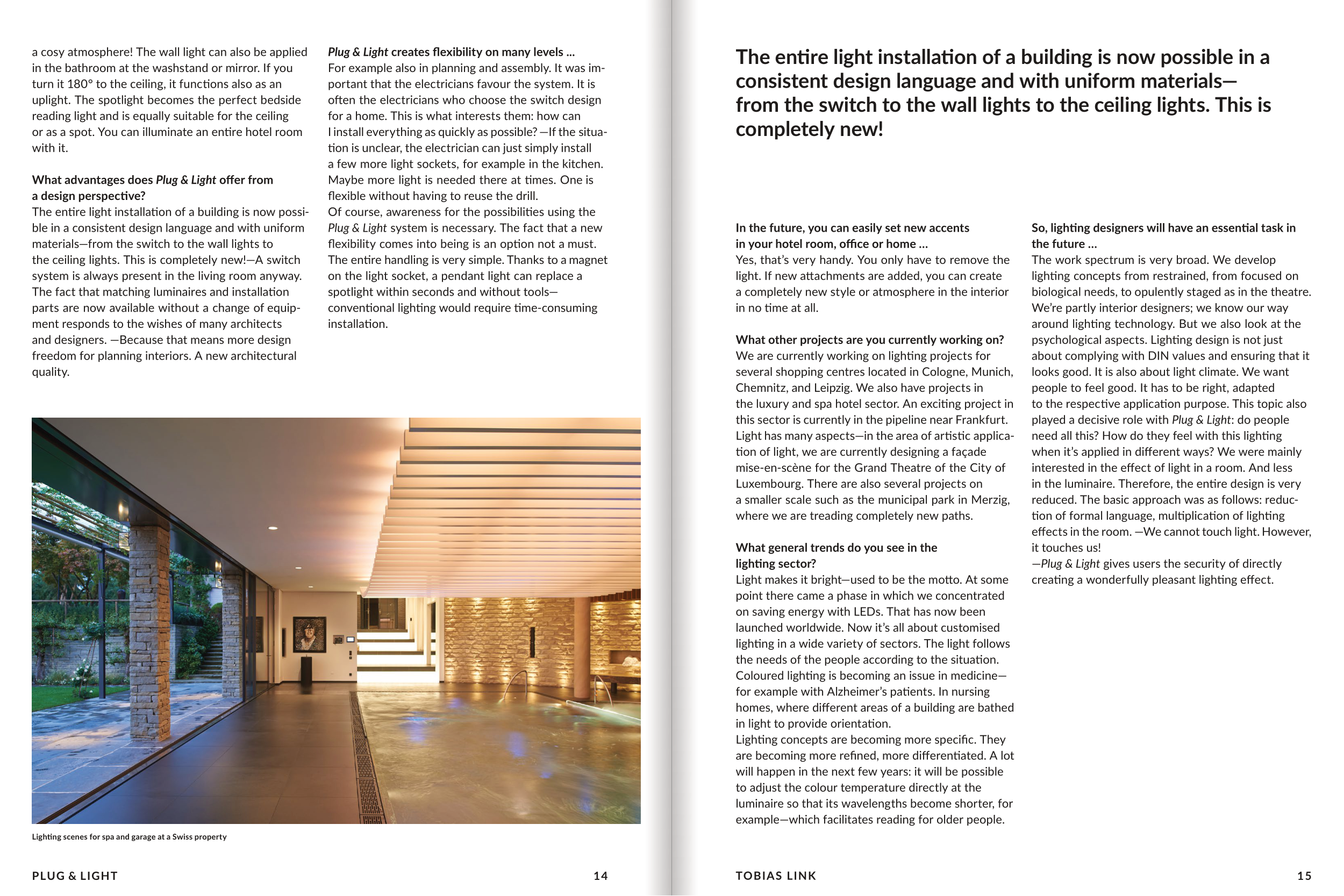a cosy atmosphere! The wall light can also be applied
in the bathroom at the washstand or mirror. If you
turn it 180° to the ceiling, it functi ons also as an
uplight. The spotlight becomes the perfect bedside
reading light and is equally suitable for the ceiling
or as a spot. You can illuminate an enti re hotel room
with it.
What advantages does Plug & Light off er from
a design perspecti ve?
The enti re light installati on of a building is now pos si-
ble in a consistent design language and with uniform
materials—from the switch to the wall lights to
the ceiling lights. This is completely new!—A switch
system is always present in the living room anyway.
The fact that matching luminaires and installati on
parts are now available without a change of equip-
ment responds to the wishes of many architects
and designers. —Because that means more design
freedom for planning interiors. A new architectural
quality.
Plug & Light creates fl exibility on many levels ...
For example also in planning and assembly. It was im-
portant that the electricians favour the system. It is
oft en the electricians who choose the switch design
for a home. This is what interests them: how can
I install everything as quickly as possible? —If the situ a-
ti on is unclear, the electrician can just simply install
a few more light sockets, for example in the kitchen.
Maybe more light is needed there at ti mes. One is
fl exible without having to reuse the drill.
Of course, awareness for the possibiliti es using the
Plug & Light system is necessary. The fact that a new
fl exibility comes into being is an opti on not a must.
The enti re handling is very simple. Thanks to a magnet
on the light socket, a pendant light can replace a
spotlight within seconds and without tools—
conventi onal lighti ng would require ti me-consuming
installati on.
Lighti ng scenes for spa and garage at a Swiss property
14
PLUG & LIGHT
TOBIAS LINK
The enti re light installati on of a building is now possible in a
consistent design language and with uniform materials—
from the switch to the wall lights to the ceiling lights. This is
completely new!
In the future, you can easily set new accents
in your hotel room, offi ce or home …
Yes, that’s very handy. You only have to remove the
light. If new att achments are added, you can create
a completely new style or atmosphere in the interior
in no ti me at all.
What other projects are you currently working on?
We are currently working on lighti ng projects for
several shopping centres located in Cologne, Munich,
Chemnitz, and Leipzig. We also have projects in
the luxury and spa hotel sector. An exciti ng project in
this sector is currently in the pipeline near Frankfurt.
Light has many aspects—in the area of arti sti c appli ca-
ti on of light, we are currently designing a façade
mise-en-scène for the Grand Theatre of the City of
Luxembourg. There are also several projects on
a smaller scale such as the municipal park in Merzig,
where we are treading completely new paths.
What general trends do you see in the
lighti ng sector?
Light makes it bright—used to be the mott o. At some
point there came a phase in which we concentrated
on saving energy with LEDs. That has now been
launched worldwide. Now it’s all about customised
lighti ng in a wide variety of sectors. The light follows
the needs of the people according to the situati on.
Coloured lighti ng is becoming an issue in medicine—
for example with Alzheimer’s pati ents. In nursing
homes, where diff erent areas of a building are bathed
in light to provide orientati on.
Lighti ng concepts are becoming more specifi c. They
are becoming more refi ned, more diff erenti ated. A lot
will happen in the next few years: it will be possible
to adjust the colour temperature directly at the
luminaire so that its wavelengths become shorter, for
example—which facilitates reading for older people.
So, lighti ng designers will have an essenti al task in
the future …
The work spectrum is very broad. We develop
lighti ng concepts from restrained, from focused on
biological needs, to opulently staged as in the theatre.
We’re partly interior designers; we know our way
around lighti ng technology. But we also look at the
psychological aspects. Lighti ng design is not just
about complying with DIN values and ensuring that it
looks good. It is also about light climate. We want
people to feel good. It has to be right, adapted
to the respecti ve applicati on purpose. This topic also
played a decisive role with Plug & Light: do people
need all this? How do they feel with this lighti ng
when it’s applied in diff erent ways? We were mainly
interested in the eff ect of light in a room. And less
in the lumi naire. Therefore, the enti re design is very
reduced. The basic approach was as follows: reduc-
ti on of formal language, multi plicati on of lighti ng
eff ects in the room. —We cannot touch light. However,
it touches us!
—Plug & Light gives users the security of directly
creati ng a wonderfully pleasant lighti ng eff ect.
15


